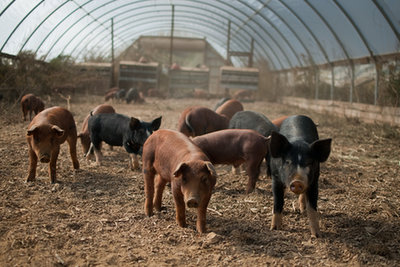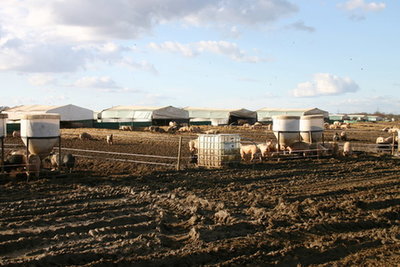interview
This use-case aims to enhance transparency and traceability of meat throughout the production chain. It explores the interoperability of information systems at the farm, during transport, at the slaughterhouse and at the point of sale using an EPCIS infrastructure.
This use-case encompasses the whole pork meat production chain, from the farm to the consumer’s plate, with the aim to increase transparency and traceability. Why is this needed?
In the meat industry, the information exchange between retailers and slaughterhouses slowly starts to digitize. Yet, only a very small proportion of the information originates from farmers. The farmers themselves also get very little digitized feedback from the food chain downstream. Within this use case, we want to include farmers in the digital information exchange. In the first place for regulatory reasons. In the near future, we foresee that farmers cannot be a part of the supply chain unless their products have digital provenance proof. We see such regulatory pressure already in other industries, such as the fishing industry.
Secondly, we think that farmers can benefit a lot. The combination of monitoring data from the farms with data from downstream will give farmers a clear insight in the results of their actions. Currently, most farmers rely on experience and gut feeling. To combine this with solid data will help them to make better decisions, we expect.


In the EU, regulations on, for example, provenance, traceability and labelling are in place. These require good administration and information sharing along the production chain. Can you explain what advantages this use-case adds to current practice?
In spite of these regulations, practices vary a lot across Europe. Where I come from in Greece, most farmers don’t use farm management information systems, whereas farmers in the Netherlands, UK or Germany often do. Still, those systems do not interact with other systems across the supply chain. Information exchange is mainly happening manually and on paper. The information on paper is not fed into a system, which makes it nearly impossible to draw conclusions on how decisions at the farm affect meat quality.
We need to close the information loop to get feedback. When farmers link their own farm management information system with the information from the slaughterhouse, for example, they get the full picture of what is happening at their farm. It could eventually even help them to get better prices for their products.
How so?
Because then farmers can prove the added-value of their practice to the consumer. They can prove that their meat is organic and their cows graze outside. The digital certification is based on evidence collected 24/7 instead of inspections every now and then. It’s much more credible.
So in a way you’re connecting the endpoints of the chain.
Yes, that’s our ambition, because the two ends of the chain are also the smaller players. The big companies in the middle manage and analyse their data quite well. Both the consumers and the farmers don’t have this infrastructure yet. With our tools, we believe we can support farmers to share in the advantages of the digital revolution.
EPCIS is an information standard that helps trading partners to share information about the physical movement and status of products as they travel throughout the supply chain – from business to business and ultimately to consumers. Can you explain how this use-case is related to EPCIS?
We insist on using EPCIS because it is a worldwide standard that is already in place in part of the meat supply chain. At the moment, even the most advanced farm management information systems do not use protocols that enable interoperability with other systems. In this use-case, we want to close that gap. We will develop an EPCIS enabled interface so that farmers can register what happens at the farm and share that information with the whole supply chain. It’s a translation problem, but also an infrastructural and a technical problem. One of our actions is to identify what kind of events happen on a farm that need to be included in the EPCIS standard. Another thing we’re working on is how to connect sensors to an EPCIS infrastructure without flooding the system with information.
What kind of challenges do you see with regards to the implementation of IoT technology?
We see two main challenges. One is related to privacy and industrial secrecy. A few years ago, interoperability and data sharing was only a wish. Now that it becomes a reality, farmers realize that they don’t want to share everything with everybody. Access control for the farmers is an important condition.
The other challenge is the ever-increasing volume of data. We need to set up an infrastructure that can handle a few thousand events per day and stays reliable when scaled up.
In four years’ time, what will you have achieved?
By then, we hope to have a system in place that is working,takes farmer concerns into consideration and is mature enough to bring to the market.
We plan to have a prototype that will demonstrate at least some of the concepts in a few months. Our development process is iterative. We intend to reveal the product at an early stage and involve farmers, other use-cases and practitioners from then on. Their feedback will help us make the right decisions for further development. We cannot make all the design choices alone, we need the potential customers to be involved.
Who are your potential customers?
We’ve got several options. Farmers could be the customers, but it could also be a module in farm management information systems. Or farm associations offer the service to their members as a group. It also depends on how the regulations develop and where the pressure for more information is felt. Maybe slaughterhouses install the module for the farmers, because they need it to reach certain markets. We don’t know precisely yet, but we are convinced that the product will be useful.
Partners in this use case:
Author: Renske Solkesz, Schuttelaar & Partners
use case
meat transparency & traceability
Ioannis Athanasiadis
Assistant Professor at Wageningen University (NL). Teaches Data Management, Models for ecological systems and Software engineering.





